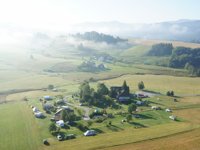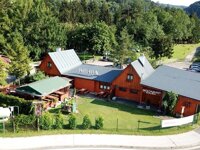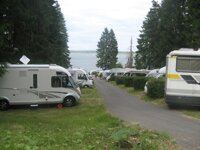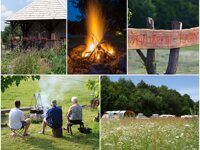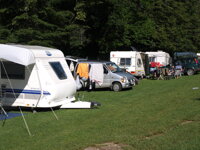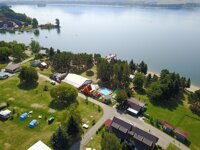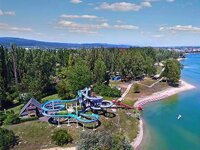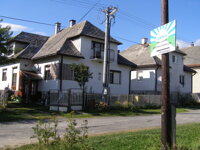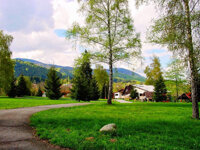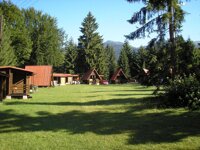Camping in Slovakia
10 campsites in Slovakia
Campsite Listing Google Map
The following consent is required:
Tracking & performance, Targeting & advertising.
Slovakia
Encircled by no fewer than five countries, Slovakia gained independence in 1993, but despite its many cultural influences, it has a strong identity of its own. This is apparent in its folklore, which has its most powerful manifestation in the nationwide Folklore Festival.
Camping in Slovakia gives you easy access to the country’s diverse countryside: the soaring peaks of the Tatra Mountains in the north, the Danubian Lowland in the southwest and the extraordinary caves such as the Dobšinská Ice Cave in the east. Consequently, there are lots of opportunities for outdoor activities such as caving, walking and skiing.
One of Slovakia’s most interesting locations is Banská Štiavnica, the country’s oldest mining town set in a volcanic landscape. Once a significant source of gold and silver, it is now rich with museums and churches and offers an insight into the country’s history.
Campsites in Slovakia provide a great base to enjoy all the country has to offer. Choose between Alan Rogers inspected and selected sites and alternatives in each region, and select a pitch or accommodation to complete your search.
Unknown matrix block type: tableOfContents2!

Basic Information
Capital Bratislava
Currency Euro
Language(s) Slovak
Time Zones CET (UTC+1)
Summer (DST) CEST (UTC+02)
Telephone Code +421
Units Metric
EU Member Yes
Schengen Area Yes
Tourism Website www.slovakia.com
Slovakia is part of the European Union and the Schengen Area; however, customs inspections are occasionally conducted on individuals and vehicles crossing the border to ensure compliance with Slovakia's regulations.
Shopping in Slovakia
The capital city, Bratislava, is the primary shopping destination in Slovakia. There are various shopping options here, including modern shopping centres and traditional markets. Bratislava has several shopping centres, such as Aupark, Eurovea, and Central. These malls feature a variety of shops, from international brands to local boutiques, dining options and entertainment facilities. The city also boasts conventional markets like the Old Market Hall (Stará Tržnica), where you can find fresh produce, local products, and hand-crafted items.
Visitors seeking more traditional Slovakian souvenirs can find them at the Slovak Republic’s unique shops operated by the ULUV, the country’s official folk art production centre. Elaborately embroidered folk costumes, pillowcases, corn husk and wire crafts, carved wooden figures, and ceramic goods are the most popular handmade items sold at these shops. Wooden sheep milk pitchers called črpák, decorated shepherd’s axes known as valaška, and long wooden shepherd’s flute called fujara are also sold in the Slovak Republic’s rural sheep farming villages.
Shopping hours in Slovakia are typically as follows:
For most shops, weekdays (Monday to Friday): 9:00 a.m. - 7:00 p.m.
Saturdays: 9:00 a.m. - 12:00 p.m. for many shops, though some shopping centres might have longer hours.
Sundays: Most shops are closed, with a few exceptions in tourist areas or convenience stores.
Money in Slovakia
Slovakia uses the euro as its official currency. ATMs are readily available in almost all towns and cities, although it is advisable to carry some cash, especially when visiting smaller towns and villages where card acceptance may be limited.
Public Holidays in Slovakia
- The day of the establishment of the Slovak Republic: January 1st
- Epiphany: January 6th
- Good Friday, Easter Monday
- Labour Day: May 1st
- Day of Victory over Fascism: May 8th
- St. Cyril and St. Methodius Day: July 5th
- Slovak National Uprising Day: August 29th
- Constitution Memorial Day: September 1st
- Day of the Virgin Mary of the Seven Sorrows: September 15th
- All Saints Day: November 1st
- Day of the Fight for Freedom and Democracy: November 17th
- Christmas Eve: December 24th
- Christmas Day: December 25th
- Boxing Day/St. Stephen’s Day: December 26th
Please note Some dates are moveable, so please check before travelling.
Driving in Slovakia

Visitors to Slovakia who wish to drive in the country must comply with the following requirements:
- A valid driver's license: Visitors must have a valid driver's license from their home country.
- Car insurance: Visitors must have valid car insurance for their vehicle, covering both the driver and passengers.
- Road rules: In Slovakia, you drive on the right and overtake on the left. Trams and vehicles from the right generally have priority. Visitors must follow Slovakian traffic laws, including speed limits, traffic signals, and road signs.
- If your vehicle does not have the UK identifier within the number plate, you will require a UK sticker when driving in Slovakia.
- Safety equipment: It is mandatory to carry a warning triangle, A fire extinguisher, A first-aid kit and spare bulbs.
- Minimum driving age: The minimum driving age is 18.
- Although in good condition, many main roads only have a single carriageway in each direction, so beware of cars overtaking, especially on bends
- You will have to pay to use the motorways - you'll need an e-vignette as proof of payment, which can be bought online or at petrol stations, post offices and border stations.
- Slovakia has a zero-tolerance policy on drink and drug-driving. The limit for all drivers is 0.00%. Police can test any driver suspected of being over the limit, and refusing to take a test could see you fined up to €1,300.
- Many mountain roads link the north and south of Slovakia; during the winter, many of these roads are impassable and should be avoided.
Emergency Services in Slovakia
- European Emergency Number 112
- Fire and rescue 150
- Emergency Medical service 155
- Police 158
Weather in Slovakia
SLOVAKIA WEATHERSlovakia experiences a temperate continental climate with distinct seasons throughout the year.
Spring in Slovakia is characterised by gradually warming temperatures. March can still be quite cold, with occasional snowfall, but temperatures begin to rise by April. May sees milder conditions, with daytime temperatures ranging from around 10 °C in March to 20°C in May. It's a transitional period, and rain is expected.
Summer is the warmest season in Slovakia. June is usually pleasant, with temperatures ranging from 20°C to 25°C, and it's a great time to visit. July and August are the warmest months, with temperatures averaging around 25°C to 30°C, but heatwaves can occasionally push temperatures higher. Summers can be wet with frequent thunderstorms and rainfall.
Autumn brings gradually cooler temperatures. September can still be pleasantly warm, with average temperatures around 15°C to 20°C. As the season progresses, temperatures drop, and by November, daytime temperatures are usually around 5°C to 10°C. The trees change into autumn colours, making it a popular time for tourism.
Winters in Slovakia are cold, and snow is expected. December is the start of the winter season, with temperatures ranging from -5°C to 0°C. January and February are the coldest months, with temperatures often dropping below freezing, going from -8°C to -2°C. Snowfall is frequent, and many regions offer winter sports activities.
